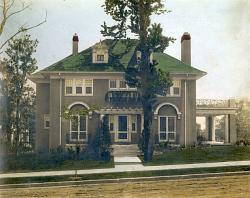 | |||||||
| Home | Email Us | Find It | What's New | Back | Next | ||
| VIEWER MESSAGES | ||
|
| MISCELLANEOUS | ||||
|
||||
 Picture dated c. 1920
Click image to enlarge
Home on 81st Avenue at Austin Street, Kew Gardens, NY. A black and white copy of this c. 1920 photograph appeared with the original article.
|
Kew Gardens Highest Point in Queens
Situated on the summit of Queens Borough, with an elevation of 150 to 170 feet above sea level, and with a clear sweep of view from the Atlantic Ocean to Long Island Sound, is Kew Gardens, one of the finest and loveliest home developments. Residents of this community claim that it is one of the coolest in the Borough, while records show that its climate is one of the healthiest. The contour of the land is gently rolling and the hills are covered with fine old trees. This natural charm has been preserved and augmented by landscape artists, while streets and sidewalks, storm and sanitary sewers, water, gas an electricity supply the modern conveniences.
This is the vision that Edward Richmond, a noted landscape artist, and Albon P. Man saw when they purchased the land about fifty years ago. Their purchase included the property now known as Richmond Hill, which they immediately began to develop, and were so successful that today it is one of the prettiest and most thickly populated suburban communities in New York City.
However, seeing the possibilities for more artistic development of the northern portion of their purchase, when opportunity offered, they reserved this portion, with nearly a mile frontage on Forest Park which assures it from undesirable encroachment for all time to come.
The opportunity came ten years ago with the electrification and improvement of the Long Island Railroad, and the establishment of a station at that point, putting the development within sixteen minutes of Pennsylvania Terminal. The tracks through the property are depressed, and no house in the development is more than ten minutes walk from the station.
Began Work in 1912
In 1912, the work of clearing the land and laying out and paving the streets was begun. Kew Gardens is a culmination of fifty years of careful planning and development by the Man family, who have taken a large part in the building of this Borough. To date, about 350 homes have been built, at a cost of several million dollars.
Here as in other similar sections, the community spirit is strong and has shown itself in the organization of the Kew Gardens Country Club and several civic organizations. The Country Club is one of the finest and best equipped clubs in the metropolitan district and serves as a focal point for all of the community's activities. It contains bachelor quarters, lounge rooms, bowling alleys, billiard rooms, etc. There are also eighteen tennis courts, with provision for other out-door sports, while convenient to the section, in Forest Park is an eighteen-hole golf course.
In the building of homes, while no distinct type of architecture has been adhered to, care has been taken that the houses shall harmonize. In the construction work, both brick and frame have been used, and the houses are for the most part of the English and Colonial type.
To meet the need of those who do not wish to take care of homes, yet desire to establish themselves in the community, the Kew Gardens Inn, a large four-story brick structure, was built. It stands at the junction of Queens Boulevard and Union Turnpike, surrounded by large grounds laid out in attractive form. It is operated as one of the chain of hotels under the management of Sheriff David H. Knott. It was opened last summer and has been successful from the start.
Soon too, the Gardens is to have an apartment house of attractive type, erected by the East Richmond Hill Land Company, and planned by Andrew J. Thomas. It will be located on Lefferts Avenue, near the railroad station, standing well back in the street, and will cover only 36 percent of the ground. The house will be built in three units and will accommodate thirty-six families. They will be three stories in height and will involve an expenditure of between four and five hundred thousand dollars.
Recently, Park Lane, a street 100 feet wide and running for more than a mile from Union Turnpike along the boundary of Forest Park, has been opened and will be developed as one of the prettiest sections of the Gardens. Already a number of plots have been sold.
A deed was filed in the Queens County Clerk's Office a few weeks ago covering twenty-six acres of land now included in Kew Gardens and Forest Hills, which is declared to be the oldest original deed for land in Queens County in existence. The deed bears the date of March 22, 1753, and is made by David Springsteen to his son, Casparus. The consideration named in the deed was "love and affection and eighty-five pounds lawful money of the province of New York." The land today is worth several hundred thousand dollars.